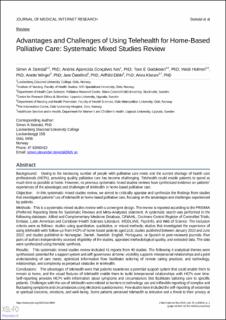| dc.contributor.author | Steindal, Simen Alexander | |
| dc.contributor.author | Nes, Andrea | |
| dc.contributor.author | Godskesen, Tove | |
| dc.contributor.author | Holmen, Heidi | |
| dc.contributor.author | Winger, Anette | |
| dc.contributor.author | Österlind, Jane | |
| dc.contributor.author | Dihle, Alfhild | |
| dc.contributor.author | Klarare, Anna | |
| dc.date.accessioned | 2024-04-10T12:04:40Z | |
| dc.date.available | 2024-04-10T12:04:40Z | |
| dc.date.created | 2023-09-23T14:25:09Z | |
| dc.date.issued | 2023 | |
| dc.identifier.citation | Steindal SA, Nes AAG, Godskesen TE, Holmen H, Winger A, Österlind J, Dihle A, Klarare A Advantages and Challenges of Using Telehealth for Home-Based Palliative Care: Systematic Mixed Studies Review J Med Internet Res 2023;25:e43684 | en_US |
| dc.identifier.issn | 1438-8871 | |
| dc.identifier.uri | https://hdl.handle.net/11250/3125812 | |
| dc.description.abstract | Background: Owing to the increasing number of people with palliative care needs and the current shortage of health care professionals (HCPs), providing quality palliative care has become challenging. Telehealth could enable patients to spend as much time as possible at home. However, no previous systematic mixed studies reviews have synthesized evidence on patients’ experiences of the advantages and challenges of telehealth in home-based palliative care.
Objective: In this systematic mixed studies review, we aimed to critically appraise and synthesize the findings from studies that investigated patients’ use of telehealth in home-based palliative care, focusing on the advantages and challenges experienced by patients.
Methods: This is a systematic mixed studies review with a convergent design. The review is reported according to the PRISMA (Preferred Reporting Items for Systematic Reviews and Meta-Analyses) statement. A systematic search was performed in the following databases: Allied and Complementary Medicine Database, CINAHL, Cochrane Central Register of Controlled Trials, Embase, Latin American and Caribbean Health Sciences Literature, MEDLINE, PsycInfo, and Web of Science. The inclusion criteria were as follows: studies using quantitative, qualitative, or mixed methods; studies that investigated the experience of using telehealth with follow-up from HCPs of home-based patients aged ≥18; studies published between January 2010 and June 2022; and studies published in Norwegian, Danish, Swedish, English, Portuguese, or Spanish in peer-reviewed journals. Five pairs of authors independently assessed eligibility of the studies, appraised methodological quality, and extracted data. The data were synthesized using thematic synthesis.
Results: This systematic mixed studies review included 41 reports from 40 studies. The following 4 analytical themes were synthesized: potential for a support system and self-governance at home; visibility supports interpersonal relationships and a joint understanding of care needs; optimized information flow facilitates tailoring of remote caring practices; and technology, relationships, and complexity as perpetual obstacles in telehealth.
Conclusions: The advantages of telehealth were that patients experience a potential support system that could enable them to remain at home, and the visual features of telehealth enable them to build interpersonal relationships with HCPs over time. Self-reporting provides HCPs with information about symptoms and circumstances that facilitates tailoring care to specific patients. Challenges with the use of telehealth were related to barriers to technology use and inflexible reporting of complex and fluctuating symptoms and circumstances using electronic questionnaires. Few studies have included the self-reporting of existential or spiritual concerns, emotions, and well-being. Some patients perceived telehealth as intrusive and a threat to their privacy at home. To optimize the advantages and minimize the challenges with the use of telehealth in home-based palliative care, future research should include users in the design and development process. | en_US |
| dc.language.iso | eng | en_US |
| dc.publisher | JMIR Publications | en_US |
| dc.rights | Navngivelse 4.0 Internasjonal | * |
| dc.rights.uri | http://creativecommons.org/licenses/by/4.0/deed.no | * |
| dc.subject | mobile phone | en_US |
| dc.subject | telemedicine | en_US |
| dc.subject | review | en_US |
| dc.subject | systematic mixed studies | en_US |
| dc.subject | home-based palliative care | en_US |
| dc.subject | health care technology | en_US |
| dc.subject | eHealth | en_US |
| dc.subject | digital health | en_US |
| dc.title | Advantages and challenges of using telehealth for home-based palliative care: A systematic mixed studies review. | en_US |
| dc.type | Peer reviewed | en_US |
| dc.type | Journal article | en_US |
| dc.description.version | publishedVersion | en_US |
| dc.rights.holder | ©Simen A Steindal, Andréa Aparecida Gonçalves Nes, Tove E Godskesen, Heidi Holmen, Anette Winger, Jane Österlind, Alfhild Dihle, Anna Klarare | en_US |
| dc.source.pagenumber | 1-15 | en_US |
| dc.source.volume | 25 | en_US |
| dc.source.journal | Journal of Medical Internet Research | en_US |
| dc.identifier.doi | 10.2196/43684 | |
| dc.identifier.cristin | 2178181 | |
| cristin.ispublished | true | |
| cristin.fulltext | original | |
| cristin.qualitycode | 2 | |

